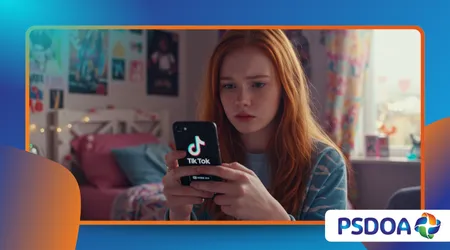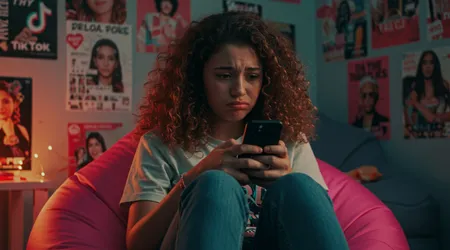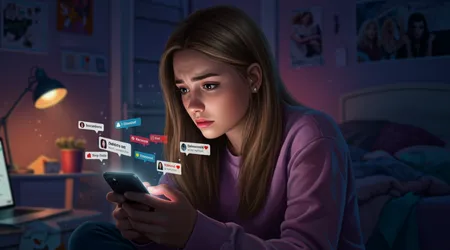How TikTok Trends Are Rewiring Teen Identity

How TikTok Trends Are Rewiring Teen Identity shapes the way adolescents perceive themselves in a digital age.
Anúncios
With over 1.7 billion users, TikTok dominates youth culture, offering a platform where short videos fuel creativity and connection.
Its algorithm curates hyper-personalized content, making it a powerful force in identity formation. This article explores how viral trends influence teens’ self-expression, social dynamics, and psychological well-being.
We’ll unpack the mechanisms behind TikTok’s impact, from algorithm-driven microtrends to the pressures of performative self-presentation, while grounding our insights in real-world examples and current research.
TikTok’s meteoric rise since 2016 has transformed it into a cultural juggernaut, especially for teens aged 13–19, who spend an average of three hours daily on social media.
Anúncios
The platform’s appeal lies in its accessibility: anyone with a smartphone can create and share content, from dance challenges to mental health confessions. But beneath the surface of fun and creativity, TikTok’s trends subtly rewire how teens construct their identities.
Are these trends empowering self-discovery or fostering a homogenized sense of self? Let’s dive into the psychological currents driving this phenomenon.
The Algorithm as Identity Architect
TikTok’s algorithm is a master curator, tailoring content to individual preferences with uncanny precision. It analyzes user behavior likes, watch time, and searches to deliver a bespoke “For You” page.
This creates an echo chamber where teens are exposed to trends that resonate with their existing interests, reinforcing certain identity markers. For example, a teen exploring #BookTok might embrace a “reader” persona, curating their online presence around literary aesthetics.
The algorithm’s power lies in its ability to amplify microtrends, niche aesthetics like “cottagecore” or “dark academia.” These trends offer ready-made identity templates, complete with visual cues and behaviors.
A 2022 Pew Research Center study found 67% of U.S. teens use TikTok, with 16% engaging almost constantly. This immersion shapes how teens see themselves, often nudging them toward performative identities that align with viral aesthetics.
Yet, this algorithmic curation can limit exploration. Teens may feel confined to trends their “For You” page endorses, reducing their identity to algorithm-approved boxes.
A teen adopting “e-girl” aesthetics might feel pressured to maintain that persona online, even if it clashes with their offline self.
++ Parasocial Relationships: Falling for Someone Who Doesn’t Know You Exist
This dynamic raises questions about authenticity: are teens choosing their identities, or is the algorithm choosing for them?
The constant feedback loop of likes and comments further molds identity. Positive reinforcement for a #OOTD (outfit of the day) post can solidify a teen’s fashionista persona, while lack of engagement might prompt a shift.
This external validation ties self-worth to online metrics, a risky proposition for developing minds. The algorithm doesn’t just reflect preferences it actively shapes them, crafting identities in its digital image.

Microtrends and the Pressure to Perform
How TikTok Trends Are Rewiring Teen Identity manifests vividly in microtrends hyper-specific aesthetics or behaviors that explode and fade rapidly.
Think of the “VSCO girl” trend or the “clean girl” look, each dictating clothing, slang, and even values. Teens adopt these trends to signal belonging, but the pressure to perform can be intense.
A teen might spend hours perfecting a #GRWM (get ready with me) video to fit the “clean girl” mold, only to feel inadequate if it flops.
Microtrends thrive on TikTok’s fast-paced ecosystem, where content must grab attention in seconds. This creates a culture of performative authenticity, where teens craft idealized versions of themselves.
For instance, Sarah, a 16-year-old from Chicago, started posting #MentalHealth content after seeing viral therapy-related videos.
Also read: The Rise of “Main Character Syndrome” on Social Media
While empowering, she felt compelled to exaggerate her struggles to gain traction, blurring the line between authenticity and performance.
The rapid turnover of trends also fuels anxiety. Teens must stay “on trend” to remain relevant, a Sisyphean task given TikTok’s fleeting cycles.
A 2024 study in Humanities and Social Sciences Communications noted significant gender differences in content consumption, with girls gravitating toward beauty and psychology-related trends, amplifying pressure to conform to idealized images.
This relentless pace can erode self-esteem, as teens chase an ever-shifting ideal.
Moreover, microtrends often promote consumerism. The “old-money core” aesthetic, for example, encourages teens to buy specific clothing to embody a persona, tying identity to material goods.
This capitalist undercurrent, as noted in a 2024 Fashion is Psychology article, fosters a sense of emptiness when trends fade. Teens are left chasing the next aesthetic, perpetually reconstructing their identities to stay relevant.
Social Connection or Social Comparison?
TikTok fosters a sense of community, connecting teens through shared interests like #KPop or #MentalHealth.
These virtual tribes offer belonging, especially for marginalized youth. For instance, Jay, a nonbinary teen from Texas, found solace in #QueerTok, where they connected with others sharing similar experiences.
This peer support can bolster self-acceptance, as a 2024 JMIR Infodemiology study found, noting TikTok’s role in reducing mental health stigma.
However, this connection often comes with a shadow: social comparison. Teens compare themselves to polished influencers, whose curated lives set unrealistic standards.
The #FitTok trend, with its chiseled bodies and intense workouts, can make a teen feel inadequate if they don’t match the ideal.
]Read more: Digital Dopamine: How Apps Hijack the Reward System
This comparison, rooted in psychological theories of upward social comparison, can dent self-esteem, especially when likes and followers become proxies for worth.
The platform’s duet and stitch features amplify this dynamic. Teens can directly engage with others’ content, either mimicking or critiquing it. While creative, these features invite judgment, as teens measure their videos against viral originals.
The pressure to “go viral” can push teens to adopt inauthentic personas, sacrificing individuality for clout. This tension between connection and comparison underscores How TikTok Trends Are Rewiring Teen Identity.
Communities on TikTok also carry risks of echo chambers. Teens immersed in #AnxietyTok might over-identify with mental health labels, as seen in a 2022 Taylor & Francis study on self-diagnosis trends.
While this can normalize struggles, it risks pathologizing normal emotions, leading teens to adopt diagnoses as core identity traits. The line between community and conformity blurs, reshaping how teens perceive themselves.
The Mental Health Paradox
How TikTok Trends Are Rewiring Teen Identity intersects with mental health in complex ways. TikTok’s #MentalHealth hashtag, with over 100 billion views by 2023, has democratized conversations about anxiety and depression.
Teens share coping strategies, like journaling or mindfulness, in bite-sized videos, making mental health accessible. Yet, the platform’s format can trivialize serious issues, reducing complex disorders to 15-second soundbites.
The “stupid walk challenge,” where users humorously tackled mental health struggles, exemplifies this paradox. It fostered connection but risked glamorizing distress, as noted in a 2024 JMIR Infodemiology study.
Teens might feel validated but also pressured to aestheticize their struggles, turning pain into performance. This can distort self-perception, tying identity to mental health labels rather than holistic selfhood.
Misinformation is another concern. Unqualified creators often share mental health advice, leading to misguided self-diagnoses.
A 2022 PMC study highlighted how teens adopt labels like ADHD after engaging with TikTok content, sometimes without clinical validation.
This trend, while empowering for some, can confuse identity development, as teens internalize diagnoses as personality traits.
The constant exposure to mental health content can also overwhelm. Teens scrolling through #TraumaTok may encounter triggering material, exacerbating anxiety.
The algorithm’s tendency to push similar content creates a feedback loop, where teens’ identities become tethered to distress. This paradox empowerment versus harm highlights TikTok’s dual role in shaping mental health narratives.
Consumerism and Identity as Commodity
TikTok’s trends often intertwine identity with consumerism, turning self-expression into a marketable product. The #SkincareRoutine trend, for instance, pushes teens to buy specific products to achieve a “glow-up” aesthetic.
Brands like CeraVe capitalize on this, partnering with influencers to promote products as identity essentials. This commodification, as noted in a 2024 Fashion is Psychology piece, ties self-worth to consumption.
Teens feel pressure to buy into trends to belong. The “clean girl” aesthetic, with its minimalist makeup and sleek athleisure, requires specific brands, creating financial strain.
A teen might save up for a $50 serum to fit the trend, only to see it replaced by the next aesthetic. This cycle fosters a transactional view of identity, where selfhood is purchased rather than cultivated.
Influencer culture amplifies this. Teens see creators monetizing their personas, prompting them to emulate this model.
A 2025 Metricool report noted that consistent niche content builds “account authority,” encouraging teens to brand themselves for clout. This entrepreneurial mindset can erode authentic self-expression, as teens prioritize marketability over individuality.
The analogy of a kaleidoscope captures this dynamic: each trend is a new lens, refracting teens’ identities into fragmented, ever-shifting patterns.
While colorful, it risks obscuring the core self beneath layers of consumerism. Teens navigate this landscape, balancing self-discovery with the pressure to “sell” their identities.
The Role of Authenticity in a Curated World

How TikTok Trends Are Rewiring Teen Identity hinges on the tension between authenticity and curation. Teens crave genuine self-expression, yet TikTok’s polished ecosystem often demands performance.
The #RealTalk trend, where users share unfiltered thoughts, promises authenticity but often feels staged. A teen might post a “vulnerable” video, carefully edited to maximize engagement, blurring the line between real and rehearsed.
Authenticity is further complicated by the platform’s global reach. Teens in rural areas connect with urban influencers, adopting aesthetics misaligned with their lived realities.
A 2024 Nature study noted that teens’ digital well-being varies by content type, with curated trends often reducing agency. This disconnect can leave teens feeling like impostors in their own lives.
Yet, some find empowerment in curation. Teens like Mia, who shares #AutismAwareness content, use TikTok to reclaim narratives, crafting identities that resonate offline.
This duality curated yet authentic suggests TikTok can be a tool for self-discovery if navigated thoughtfully. The challenge lies in balancing external pressures with inner truth.
The platform’s emphasis on virality can undermine this balance. Teens may prioritize trends over personal values, adopting personas that don’t reflect their core selves.
The #VanLife trend, for example, romanticizes a nomadic lifestyle, prompting some teens to project an identity they can’t sustain. This performative cycle risks alienating teens from their authentic selves.
Table: TikTok’s Impact on Teen Identity (2024 Data)
| Aspect | Positive Impact | Negative Impact |
|---|---|---|
| Self-Expression | Enables creative outlets (e.g., #ArtTok) | Encourages performative personas |
| Community | Fosters belonging (e.g., #QueerTok) | Risks echo chambers and comparison |
| Mental Health | Normalizes discussions (#MentalHealth) | Promotes misinformation, self-diagnosis |
| Consumerism | Inspires creativity through products | Ties identity to material goods |
Source: Adapted from 2024 JMIR Infodemiology Study
Navigating the Future of Teen Identity
How TikTok Trends Are Rewiring Teen Identity demands a forward-looking approach. Parents and educators must guide teens to engage critically with TikTok, fostering media literacy to discern authentic self-expression from performative trends.
Workshops on digital well-being, like those piloted in British Columbia in 2024, can empower teens to navigate the platform’s influence.
Teens themselves are adapting. Many use TikTok to explore niche communities, like #Neurodiversity, finding affirmation without conforming to mainstream trends.
This selective engagement suggests resilience, as teens carve out spaces for authentic identity formation. Encouraging this agency is key to mitigating TikTok’s risks.
Policymakers also have a role. Regulations ensuring transparent algorithms and content moderation, as proposed in a 2025 EU directive, could reduce harmful content exposure.
By prioritizing mental health safeguards, TikTok can evolve into a platform that nurtures rather than rewires teen identity.
Ultimately, TikTok is a mirror reflecting teens’ desires, fears, and aspirations. Its trends offer both freedom and constraint, shaping identities in real time.
By fostering critical engagement, we can help teens wield TikTok as a tool for self-discovery, not a blueprint for conformity. What kind of identity will the next viral trend spark in you or the teens you know?
Frequently Asked Questions
Q: How do TikTok trends influence teen mental health?
A: Trends like #MentalHealth normalize discussions but can trivialize issues or spread misinformation, impacting self-perception and emotional well-being.
Q: Can TikTok help teens discover their true selves?
A: Yes, niche communities like #Neurodiversity offer affirmation, but curated trends may pressure teens into inauthentic personas.
Q: How can parents mitigate TikTok’s impact on identity?
A: Encourage media literacy, set screen time limits, and discuss the difference between online performance and real-world identity.
Q: Are TikTok trends harmful to all teens?
A: Not universally some find empowerment, but risks like comparison and consumerism can harm vulnerable teens without guidance.
